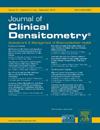dxa测量的中年人内脏脂肪组织和心血管疾病事件:Busselton健康老龄化研究
IF 1.6
4区 医学
Q4 ENDOCRINOLOGY & METABOLISM
引用次数: 0
摘要
背景:dxa测量的内脏脂肪组织(VAT)与中年人代谢综合征的发展有关,但其与心血管疾病(CVD)发病率的关系尚未研究。在Busselton健康老龄化研究中,我们评估了基线VATDXA与心血管疾病事件的纵向关联。方法:对参与者(n = 4866,女性54 %,年龄46-70岁,白人99 %)进行VATDXA评估,纵向随访中位数为7.9年。结果测量是发生心血管疾病或冠心病(CHD)事件的时间(定义为非致命性住院或死亡)。使用Cox比例风险模型对基线年龄、生活方式因素和既往心血管疾病进行校正,以检验性别分层的相关性。结果:男性和女性的VATDXA平均基线质量分别为1678±877 g和882±600 g。记录了332名(6.8 %)和245名(5.0 %)研究参与者的心血管疾病和冠心病事件。VATDXA患者的CVD和CHD事件的风险在两性中均呈近线性增加。协变量调整后,VATDXA的每个标准差(SD)增量与男性和女性心血管事件的风险比[95 %置信区间]分别为1.26[1.11-1.44]和1.30[1.10-1.55],冠心病的风险比分别为1.28[1.11-1.49]和1.40[1.14-1.72]。然而,一旦调整BMI和腰围,VATDXA不再与CVD事件独立相关。结论:VATDXA可用于识别心血管疾病和冠心病发生风险较高的中年人,但需要进一步的研究来确定VATDXA是否可以改善人体测量测量之外的风险识别。本文章由计算机程序翻译,如有差异,请以英文原文为准。
DXA-Measured Visceral Adipose Tissue and Incident Cardiovascular Disease Events in Middle-Aged Adults: Busselton Healthy Ageing Study
Background: DXA-measured visceral adipose tissue (VAT) is associated with development of metabolic syndrome in middle-aged adults, but its association with incident cardiovascular disease (CVD) has not been studied. We evaluated the longitudinal association of baseline VATDXA with incident CVD events within the Busselton Healthy Ageing study.
Methods: Participants (n = 4866, 54 % female, aged 46-70 years, ∼99 % white) were assessed for VATDXA and were followed up longitudinally for a median of 7.9 years. Outcome measures were time to incident CVD or coronary heart disease (CHD) events (defined as non-fatal hospitalisations or death). Sex-stratified associations were examined using Cox proportional hazards models adjusting for baseline age, lifestyle factors and prior CVD.
Results: Mean baseline VATDXA mass was 1678±877 g and 882±600 g in males and females respectively. Incident CVD and CHD events were recorded for 332 (6.8 %) and 245 (5.0 %) study participants. There was a near-linear increase in risk for CVD and CHD events with VATDXA in both sexes. After covariate adjustment each standard deviation (SD) increment in VATDXA was associated with a hazard ratio [95 % confidence interval] for incident CVD in males and females of 1.26 [1.11-1.44] and 1.30 [1.10-1.55] respectively, and a hazard ratio for CHD of 1.28 [1.11-1.49] and 1.40 [1.14-1.72] respectively. However, VATDXA was no longer independently associated with CVD events once adjusted for BMI and waist circumference.
Conclusion: VATDXA has utility for identifying middle-aged adults at greater risk for incident CVD and CHD but further studies are needed to determine if VATDXA can improve risk discrimination beyond anthropometric measures.
求助全文
通过发布文献求助,成功后即可免费获取论文全文。
去求助
来源期刊

Journal of Clinical Densitometry
医学-内分泌学与代谢
CiteScore
4.90
自引率
8.00%
发文量
92
审稿时长
90 days
期刊介绍:
The Journal is committed to serving ISCD''s mission - the education of heterogenous physician specialties and technologists who are involved in the clinical assessment of skeletal health. The focus of JCD is bone mass measurement, including epidemiology of bone mass, how drugs and diseases alter bone mass, new techniques and quality assurance in bone mass imaging technologies, and bone mass health/economics.
Combining high quality research and review articles with sound, practice-oriented advice, JCD meets the diverse diagnostic and management needs of radiologists, endocrinologists, nephrologists, rheumatologists, gynecologists, family physicians, internists, and technologists whose patients require diagnostic clinical densitometry for therapeutic management.
 求助内容:
求助内容: 应助结果提醒方式:
应助结果提醒方式:


